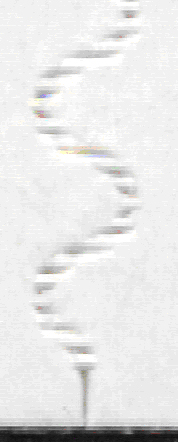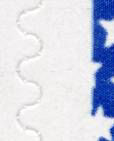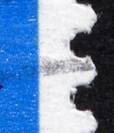|
Incision Styles |
||||||||||
|
Early self-adhesive coil production by the BEP used a variety of cutting knives in the die cutting mats. These different cutting knives produced incisions in the paper web that are distinctly different in appearance (a good magnifier will clearly show the difference). Three of the die knives produced incisions that leave part of the paper between stamps intact. These intact sections are called ‘ties’. Types A, B, and D have ties that are readily distinguished. Type D incisions are useful in detecting the inversion of a 10/10 mat because the tie pattern is not symmetrical. |
||||||||||
 |
 |
 |
 |
|||||||
| Style A | Style B | Style C | Style D | |||||||
| Style A - has ties
in the serpentine portion of the die cut but no ties in the straight top
and/or bottom portion of the die cut. Style B - has closely spaced ties (approximately nine per peak) throughout the complete die cut. Style C - has no ties in the serpentine or straight portions of the die cut. Style D - has widely spaced ties through the completed die cut. |
||||||||||
| When a 10/10 PV/VP mat using incision style D is inverted, it remains PV/VP, but the position of the peak-tip ties is changed. Figure 2 shows a stamp with a tie in the incision at the tip of each peak at the left side of the stamp. If the mat is inverted (rotated 180° on the equipment), the tie is found at the tip of the peaks at the right side of the stamp (Fig. 3). In the February 2002 issue of Coil Line, available online in the reference section, Richard Nazar designated these as “tie-tip-left (TTL)” and “tie-tip-right (TTR)”, the TTR being an inverted version of the normal TTL style D incision. | ||||||||||
 |
|
 |
||||||||
|
Fig. 2 -T T L |
Fig. 3 - T T R |
|||||||||
Web site content copyright ©
1997-2009, PNC3
Please send corrections and comments to our webmaster
Permission is granted to quote material in this web site provided that proper credit is given.
![]()